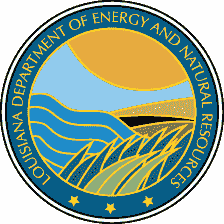Office of Conservation
Engineering Regulatory Division
Onsite Exploration & Production (E&P) Waste Storage and Disposal
|
Melanie Clore
|
|
Contact phone (225) 342-4093 MAILING ADDRESS |
| NEW & AMENDED REGULATIONS | |||||||||||||||||||||||||||||||||||||||||||||||||||||||
|
|
|||||||||||||||||||||||||||||||||||||||||||||||||||||||
| NEW OR REVISED POLICIES & ANNOUNCEMENTS | |||||||||||||||||||||||||||||||||||||||||||||||||||||||
|
Reclaimed Oilfield Waste (ROW) Staging Location Registration Form (web-based) is now available. |
|||||||||||||||||||||||||||||||||||||||||||||||||||||||
| APPLICABILITY | |||||||||||||||||||||||||||||||||||||||||||||||||||||||
|
If the waste material and/or disposal site do not meet the above definitions, the regulations and guidance provided in this document are not applicable. Common wastes that are not classified as E&P Waste include:
DENR does not have jurisdiction over the storage, treatment or disposal of any waste not classified as an E&P Waste. Instead, these non-exempt wastes are subject to LDEQ/EPA regulations. Additional information and resources regarding the E&P Waste exemption can be obtained from the EPA website and the EPA document entitled "Exemption of Oil and Gas Exploration and Production Wastes from Federal Hazardous Waste Regulations".
|
|||||||||||||||||||||||||||||||||||||||||||||||||||||||
| ON-SITE STORAGE OF E&P WASTE | |||||||||||||||||||||||||||||||||||||||||||||||||||||||
|
Contamination of a groundwater aquifer or a USDW with E&P Waste is strictly prohibited. The discharge of produced water or other E&P Waste (including drilled solids) into manmade or natural drainage or directly into state waters is allowed only in conformance with any applicable state or federal discharge regulatory program. E&P Wastes may be stored on-site in tanks (closed-loop storage systems) or within earthen impoundments or "pits". Pits may be either lined or unlined depending on the intended purpose and the types of E&P waste being stored. The Office of Conservation encourages the use of closed-loop systems for on-site E&P Waste storage. For the purpose of these regulations, a "pit" is defined as a natural topographic depression or man-made excavation used to hold E&P Waste, produced water or hydrocarbon storage brine. Lined sumps with a capacity less than 660 gallons or containment dikes, ring levees or firewalls constructed around oil/gas facilities are NOT considered pits under this definition. Pits are divided into two main categories: "Reserve Pits" - temporary earthen pits used to store only those materials used or generated in drilling and workover operations. "Production Pits" - earthen or lined storage pits for collecting E&P Waste sediment periodically cleaned from tanks and other producing facilities, for storage of produced water or other exploration and production wastes produced from the operation of oil and gas facilities, or used in conjunction with hydrocarbon storage and solution mining operations. Production Pits are further subdivided into the following nine categories:
Specific regulatory requirements for the construction and operation of pits are found in LAC 43:XIX.307.
|
|||||||||||||||||||||||||||||||||||||||||||||||||||||||
| PIT NOTIFICATION & IDENTIFICATION | |||||||||||||||||||||||||||||||||||||||||||||||||||||||
|
The required notification is to be provided on Form ENG-15 [word/PDF]. If a liner is required, liner specifications must accompany the notification form. Following notification, the Office of Conservation issues a unique Production Pit Identification number with the format NNPNNNN. The first two digits represent the parish code and the last four digits are a sequential number. Operators are to reference this number in any future correspondence with the Office of Conservation regarding the pit. |
|||||||||||||||||||||||||||||||||||||||||||||||||||||||
| PIT CLOSURE | |||||||||||||||||||||||||||||||||||||||||||||||||||||||
|
|
|||||||||||||||||||||||||||||||||||||||||||||||||||||||
| ON-SITE TREATMENT & DISPOSAL OF E&P WASTE | |||||||||||||||||||||||||||||||||||||||||||||||||||||||
|
For evaluation purposes prior to closure, E&P Waste must be analyzed for the following criteria:
Reserve pit fluids disposed of through subsurface injection or generated during drilling of a well to a depth of less than 5,000 feet with a freshwater "native" mud containing no more than 25 lbs/bbl bentonite, 0.5 lbs/bbl caustic soda or lime, and 50 lbs/bbl barite are exempt from the analytical testing requirements. All parameters are to be analyzed using standard soil testing procedures as presented in the DENR Laboratory Manual for the Analysis of Oilfield Waste by a LDEQ - LELAP accredited laboratory. All pre and post closure analytical documentation must be maintained in operator's files for at least three (3) years after completion of closure activities and must be made available upon written request from OC. On-site Disposal Methods
Prior to conducting onsite pit closure activities, an operator must make a determination that the requirements and closure limits specified by LAC 43:XIX.313 are attainable. Closure Limits for Onsite E&P Waste Disposal The criteria for land treatment, burial, solidification, or onsite land development applies to the disposal of any E&P waste remaining onsite. |
|||||||||||||||||||||||||||||||||||||||||||||||||||||||
| OTHER DISPOSAL OPTIONS | |||||||||||||||||||||||||||||||||||||||||||||||||||||||
|
Other E&P Waste disposal methods include:
Additional information regarding injection well disposal or subsurface annular injection may be obtained from the Injection and Mining Division - Underground Injection Control (UIC) Section. Additional information regarding off-site or commercial disposal may be obtained from the Environmental Division - Exploration and Production Waste Management Section. |
|||||||||||||||||||||||||||||||||||||||||||||||||||||||
| REGULATIONS | |||||||||||||||||||||||||||||||||||||||||||||||||||||||
|
|
|||||||||||||||||||||||||||||||||||||||||||||||||||||||
| POLICIES & GUIDANCE DOCUMENTS | |||||||||||||||||||||||||||||||||||||||||||||||||||||||
|
|
|||||||||||||||||||||||||||||||||||||||||||||||||||||||
| FORMS | |||||||||||||||||||||||||||||||||||||||||||||||||||||||
|
|||||||||||||||||||||||||||||||||||||||||||||||||||||||
| RELATED TOPICS | |||||||||||||||||||||||||||||||||||||||||||||||||||||||
|
|
